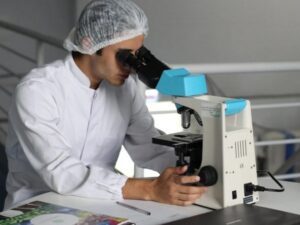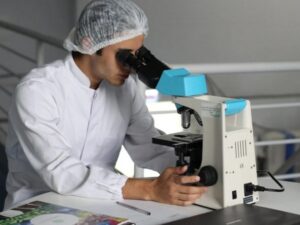Stem Cell Banking: Your Body’s Healing Potential
Searching for a future where your body holds the secret to healing itself – where your cells hold the power to regenerate and repair. That’s the incredible promise of stem cell banking. These cells have this mind-blowing ability to transform into different types of tissues. With their versatility, they could potentially treat all sorts of diseases and injuries.
But let’s back up a second. What exactly are stem cells, and why should you care about banking them? That’s what I’m going to break down for you in this guide. I want to take you on a journey through the fascinating world of stem cells and show you how storing them could unlock your body’s hidden superpowers. It’s some seriously cool stuff.
What Are Stem Cells And Why Does Banking Them Matter?
Stem cells are undifferentiated cells that can develop into various specialized cell types in the body. They are unique because they can self-renew and differentiate into different cell lineages. Stem cells are broadly classified into embryonic, fetal, adult, and umbilical cord stem cells.
Stem cell banking involves collecting and preserving stem cells, typically from the umbilical cord blood and tissue, to be used for potential future medical treatments. It is important for several reasons:
1. Stem Cells Have The Potential To Treat A Wide Range Of Diseases:
They can be used to regenerate damaged tissues and organs, such as skin, blood vessels, and pancreatic cells. This makes them valuable for treating conditions like cardiovascular diseases, type I diabetes, and blood disorders.
2. Stored Stem Cells Are Readily Available When Needed:
Unlike other sources, umbilical cord blood is collected at birth, processed, and cryopreserved for future use. This eliminates the need to search for a matching donor and wait for stem cell collection.
3. Stem Cell Banking Provides Health Insurance For The Baby And Family:
Parents gain peace of mind knowing that the preserved stem cells can treat over 90 medical conditions, including life-threatening diseases, thereby protecting their child’s health.
4. Stem Cell Banking Is Easy And Painless:
Healthcare professionals collect umbilical cord blood and tissue after childbirth without causing harm to the mother or baby. It presents a one-time opportunity to preserve a valuable biological resource.
5. Advances In Stem Cell Research Are ongoing:
As scientists continue to explore the potential of stem cells, the demand for easily accessible and high-quality stem cell samples is increasing. Banking stem cells now ensure they are available for future medical breakthroughs.
What Is The Process of Stem Cell Banking
The process of stem cell banking involves the following key steps:
Cell Collection
Stem cells are collected from various sources, including:
- Cord blood: Collected from the umbilical cord and placenta after childbirth, cord blood is a rich source of hematopoietic stem cells.
- Bone marrow: Found within spongy inner bone tissue, bone marrow harbors a diverse population of stem cells, including mesenchymal stem cells.
- Peripheral blood: Circulating in the bloodstream, peripheral blood also contains stem cells, albeit in lower numbers compared to cord blood and bone marrow.
Cell Processing
The collected cells undergo processing to ensure their viability and purity:
- Separation: Researchers separate the cells from impurities and other blood components using techniques like centrifugation and density gradient centrifugation.
- Viability assessment: Researchers test the cells to determine their ability to divide and function properly, ensuring they preserve only viable cells.
- Characterization: Stakeholders characterize the cells based on their surface markers and gene expression patterns to identify their specific type and potential applications.
Cryopreservation
To preserve the cells for long-term storage, stakeholders subject them to cryopreservation, freezing them to extremely low temperatures (-130°C or lower). They typically add Dimethyl sulfoxide (DMSO) at this step to reduce ice crystal formation.
Cell Storage
Stakeholders store the cryopreserved cells in liquid nitrogen tanks or cryogenic freezers, maintaining their frozen state and ensuring their stability over time.
Cell Thawing And Expansion
When required for therapeutic or research purposes, researchers thaw and expand the cells in a culture vessel. This process enables the cells to multiply and reach the necessary quantity for their intended use.
Throughout the stem cell banking process, stakeholders implement stringent quality control measures to ensure the safety, efficacy, and identity of the cells.
Considerations And Costs Associated With Banking
There are several key considerations and costs associated with stem cell banking:
Costs
- The initial processing fee for cord blood banking ranges from $1,500 to $3,000, covering collection, testing, and cryopreservation.
- Annual storage fees range from $150 to $300 per year.
- One-time payment options with discounts are available for those who can afford the upfront cost.
- Some banks offer monthly installment plans and financing options to make stem cell banking more affordable.
- Public cord blood banks typically provide free donations, with costs covered by the bank.
Considerations
- Quality of stem cells: It is crucial to obtain high-quality stem cells from healthy tissue, and ensure proper processing and storage to maintain potency.
- Accessibility: Private banks may be cost-prohibitive for some patients, while public banks may lack the capacity to meet demand.
- Ownership and use: Clear policies should outline ownership, usage rights, and disposition of samples, especially in case of a client’s passing or nonpayment of fees.
- Informed consent: Clients should fully understand all aspects of the biopreservation process, including risks and policies, during informed consent.
- Ethical considerations arise with stem cell banking, raising legal and social issues that the industry should responsibly address as it evolves.
- Potential for treatment: Stored stem cells have the potential to treat over 90 medical conditions, including life-threatening diseases.
What Are Ethical Considerations And Future Of Stem Cell Research
There are several key ethical considerations in stem cell research:
Embryonic Stem Cells
The use of embryonic stem cells raises ethical concerns about the moral status of the embryo, as it involves destroying embryos to derive these cells. There are debates about whether embryos can be regarded as disposable for benevolent purposes.
Informed Consent
Obtaining informed consent is crucial when collecting stem cells from donors, such as for cord blood banking. Donors must fully understand the intended use of their cells and any risks involved.
Oversight And Regulation
To ensure ethical conduct in stem cell research, stakeholders need to establish appropriate oversight and regulation. This involves setting up committees to review research protocols and policies on issues such as ownership and usage rights of stored samples.
Risks And Benefits
Healthcare professionals must carefully weigh the risks and potential benefits of stem cell interventions, especially in early clinical trials. Unproven stem cell therapies could potentially harm patients.
Accessibility And Justice
As researchers develop stem cell therapies, they raise considerations of accessibility and justice. Policymakers need to ensure fair access to these potentially expensive treatments.
Broader Societal Impacts
Stem cell research can have broader societal impacts beyond just risks and benefits. These “soft impacts” include effects on behavior, experiences, moral values, and social structures that deserve consideration.
Ethical Considerations In Stem Cell Research PDF
Acorn Biolabs Hair Follicle Stem Cell Banking
Acorn Biolabs has this cool, non-invasive way to collect and store your stem cells from hair follicles. That way, you’ve got them preserved and ready if you need regenerative treatments down the road. Here’s how it works:
First off, the collection process is super simple – they just gently pluck about 50 hairs from your scalp. No big deal, right? But those hair follicles are packed with powerful stem cells that could potentially help rejuvenate skin, regrow hair, repair tissues, and who knows what else in the future.
The neat part is that Acorn freezes those cells using cryogenics, basically stopping the aging process in its tracks. So you’ve got a stash of your younger, more potent stem cells on ice and ready to go whenever you might need them.
And get this – Acorn has proprietary methods to keep those cells viable pretty much forever. Wild, right? They recommend banking anytime between 18-65, though they admit older cells may have some limitations.
Now, the main focus for Acorn is using those banked follicle cells to combat hair loss through regenerative medicine techniques in the future. But who knows what other stem cell therapies could come along?
As for cost, it’s $250 upfront to retrieve and bank your cells. Then treatment costs would vary based on what you need done down the line.
Mallory Pruitt An Instagram Influencer About Hair Follicle Stem Cell Banking
Conclusion
The incredible potential of stem cells to treat a vast array of medical conditions is no longer a distant dream – it’s a reality that we can harness today through the power of stem cell banking. By preserving these remarkable cells in their most robust state, you’re essentially securing a personal reserve of healing potential for the future.
Whether you choose to bank stem cells from umbilical cord blood, bone marrow, or even hair follicles through innovative services like Acorn Biolabs, the benefits are clear. You’ll have immediate access to a matching source of stem cells should the need arise, eliminating the stress and delays of finding a donor.
And as research in regenerative medicine continues to advance, your banked stem cells could unlock new frontiers in treating everything from cardiovascular diseases to blood disorders and beyond.
While the process of stem cell banking requires careful consideration of costs, ethical implications, and regulatory factors, the peace of mind it provides is invaluable. By taking this proactive step, you’re not only safeguarding your health but also contributing to the greater good of scientific progress.
Frequently Asked Questions
Stem cells are undifferentiated cells capable of developing into various specialized cell types in the body. Banking them preserves these cells for potential future medical treatments, offering the promise of regenerating damaged tissues and treating a wide range of diseases.
Stem cell banking involves collecting and preserving stem cells from sources like umbilical cord blood, bone marrow, or hair follicles. The process includes cell collection, processing to ensure viability, cryopreservation at ultra-low temperatures, storage, and eventual thawing and expansion when needed.
Stem cell banking provides a form of health insurance for your family, offering readily available treatments for over 90 medical conditions, including life-threatening diseases.
Ethical considerations in stem cell research include debates over the use of embryonic stem cells, ensuring informed consent from donors, and oversight and regulation of research practices.
Stem cell banking costs typically include initial processing fees and annual storage fees. Factors to consider include the quality of stem cells obtained, and accessibility to private vs. public banks.






